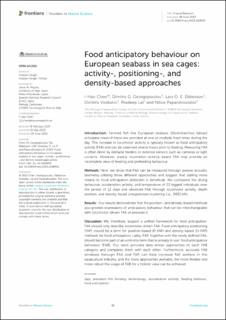| dc.contributor.author | Chen, I-Hao | |
| dc.contributor.author | Georgopoulou, Dimitra G. | |
| dc.contributor.author | Ebbesson, Lars | |
| dc.contributor.author | Voskakis, Dimitris | |
| dc.contributor.author | Lal, Pradeep | |
| dc.contributor.author | Papandroulakis, Nikos | |
| dc.date.accessioned | 2023-09-20T09:15:12Z | |
| dc.date.available | 2023-09-20T09:15:12Z | |
| dc.date.created | 2023-06-29T10:44:25Z | |
| dc.date.issued | 2023 | |
| dc.identifier.issn | 2296-7745 | |
| dc.identifier.uri | https://hdl.handle.net/11250/3090742 | |
| dc.description.abstract | Farmed fish like European seabass (Dicentrarchus labrax) anticipate meals if these are provided at one or multiple fixed times during the day. The increase in locomotor activity is typically known as food anticipatory activity (FAA) and can be observed several hours prior to feeding. Measuring FAA is often done by demand feeders or external sensors such as cameras or light curtains. However, purely locomotor-activity-based FAA may provide an incomplete view of feeding and prefeeding behaviour. Here, we show that FAA can be measured through passive acoustic telemetry utilising three different approaches and suggest that adding more means to food anticipation detection is beneficial. We compared the diving behaviour, acceleration activity, and temperature of 22 tagged individuals over the period of 12 days and observed FAA through locomotor activity, depth position, and density-based unsupervised clustering (i.e., DBSCAN). Our results demonstrate that the position- and density-based methods also provide expressions of anticipatory behaviour that can be interchangeable with locomotor-driven FAA or precede it. We, therefore, support a unified framework for food anticipation: FAA should only describe locomotor-driven FAA. Food anticipatory positioning (FAP) should be a term for position-based (P-FAP) and density-based (D-FAP) methods for food anticipation. Lastly, FAP, together with the newly defined FAA, should become part of an umbrella term that is already in use: food anticipatory behaviour (FAB). Our work provides data-driven approaches to each FAB category and compares them with each other. Furthermore, accurate FAB windows through FAA and FAP can help increase fish welfare in the aquaculture industry, and the more approaches available, the more flexible and more robust the usage of FAB for a holistic view can be achieved. | en_US |
| dc.description.abstract | Food anticipatory behaviour on European seabass in sea cages: activity-, positioning-, and density-based approaches | en_US |
| dc.language.iso | eng | en_US |
| dc.rights | Navngivelse 4.0 Internasjonal | * |
| dc.rights.uri | http://creativecommons.org/licenses/by/4.0/deed.no | * |
| dc.title | Food anticipatory behaviour on European seabass in sea cages: activity-, positioning-, and density-based approaches | en_US |
| dc.title.alternative | Food anticipatory behaviour on European seabass in sea cages: activity-, positioning-, and density-based approaches | en_US |
| dc.type | Journal article | en_US |
| dc.type | Peer reviewed | en_US |
| dc.rights.holder | © 2023 Chen, Georgopoulou, Ebbesson, Voskakis, Lal and Papandroulakis | en_US |
| dc.description.version | publishedVersion | en_US |
| cristin.ispublished | true | |
| cristin.fulltext | original | |
| cristin.qualitycode | 1 | |
| dc.identifier.doi | 10.3389/fmars.2023.1168953 | |
| dc.identifier.cristin | 2159359 | |
| dc.source.journal | Frontiers in Marine Science | en_US |
| dc.subject.nsi | VDP::Akvakultur: 922 | en_US |
| dc.subject.nsi | VDP::Aquaculture: 922 | en_US |

